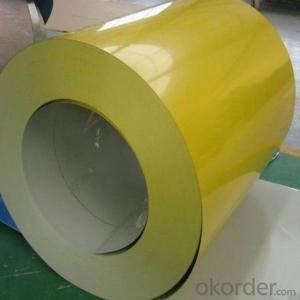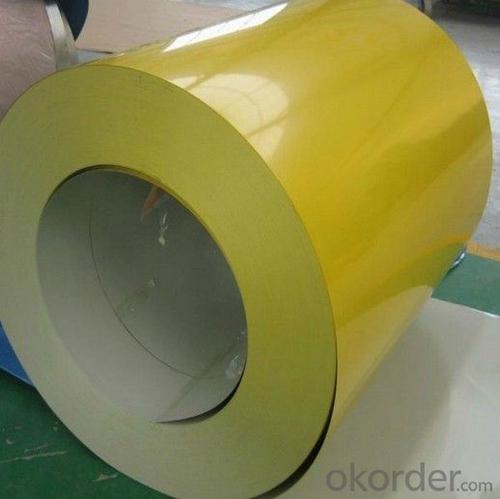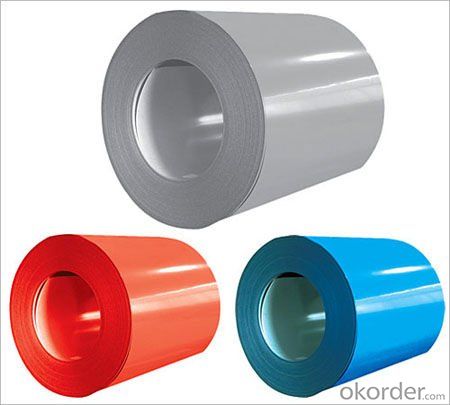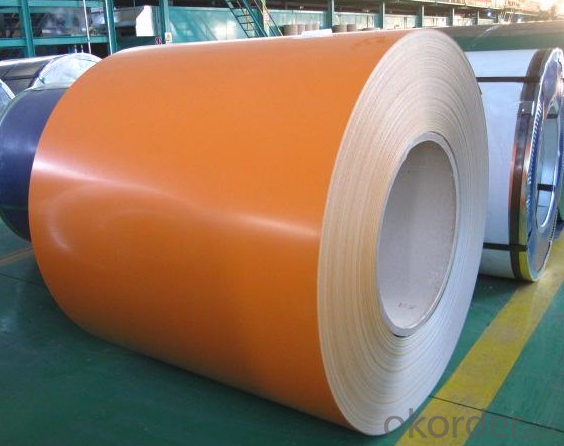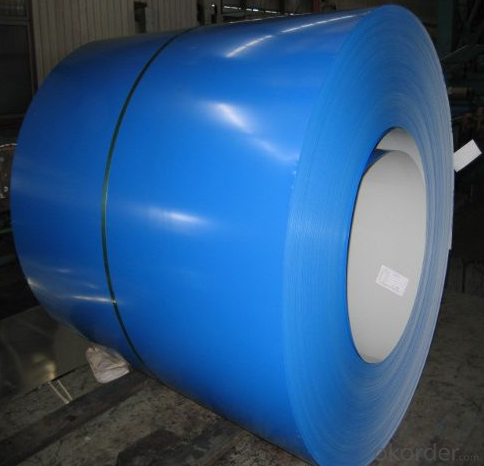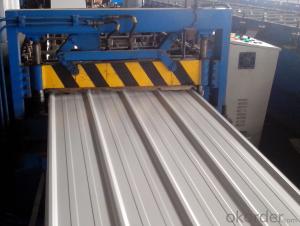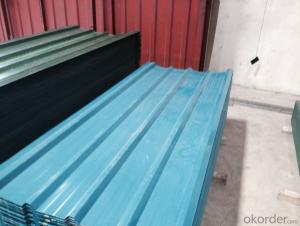Color Coated Galvanized Steel Coils SGCC, DX51D,China CNBM, Fast Delivery
- Loading Port:
- China main port
- Payment Terms:
- TT OR LC
- Min Order Qty:
- 25 m.t.
- Supply Capability:
- 100000 m.t./month
OKorder Service Pledge
OKorder Financial Service
You Might Also Like
Prepainted galvanized steel coils
Quality | Q/BQB 440-2003 | JIS G3312-1994 | EN 10326-2004 | ASTM A653-02a |
EN 10327-2004 | (BASE PLATE) | |||
(BASE PLATE) | ||||
Commercial Steel | TDC51D | CGCC | DX51D+Z/AZ | CS Type A/B/C |
Forming Steel | (TSt01,TSt02,TSt03) | CGCD1 | FS Type A, Type B | |
Drawing | TDC52D /TDC53D | - | DX52D+Z/AZ | DDS TYPE A/C |
Steel | DX53D+Z/AZ | |||
Structural | TS280GD(TStE28) | CGC400 | S280D+Z/AZ | SS275 |
Steel | TS350GD(TStE34) | CGC440 | S350D+Z/AZ | SS340 Class1 |
2) OUR SPECIFICATION OF (Prepainted galvanized steel coils) printed PPGI coils
Thickness | Width | Length of plate | Inner diameter of coil | |
0.18-1.5mm | MAX 1250mm | 1000-6000mm | 508mm/610mm |
Coated Mass OF (Prepainted galvanized steel coils) printed PPGI coils:
Base plate | Available Coated Mass(g/m^2) |
Galvanized Steel | 80, 100, 120, 160, 180,275 |
Galvalume Steel | 50, 70, 150 |
Available Painting OF (Prepainted galvanized steel coils) printed PPGI coils:
Category of Painting | Item | Code | |
Polyester | PE | ||
High-durability polyester | HDP | ||
Silicon modified polyesters | SMP | ||
Polyvinylidene fluoride | PVDF | ||
Easy-Cleaning | — | ||
Painting Thickness | Top side: 20+5microns; | ||
Bottom side: 5~7microns. | |||
Color System | Produce according to RAL Color System or as per buyer’s color sample. | ||
Painting structure | Top surface | Bottom surface | |
Primer coating | No coating | 1/0 | |
Primer coating | Primer coating | 1/1 | |
Primer coating + Finish coating | No coating | 2/0 | |
Primer coating + Finish coating | Primer coating or single back coating | 2/1 | |
Primer coating + Finish coating | Primer coating + Finish back coating | 2/2 | |
(Prepainted galvanized steel coils) printed PPGI coils
Quality | Q/BQB 440-2003 | JIS G3312-1994 | EN 10326-2004 | ASTM A653-02a |
EN 10327-2004 | (BASE PLATE) | |||
(BASE PLATE) | ||||
Commercial Steel | TDC51D | CGCC | DX51D+Z/AZ | CS Type A/B/C |
Forming Steel | (TSt01,TSt02,TSt03) | CGCD1 | FS Type A, Type B | |
Drawing | TDC52D /TDC53D | - | DX52D+Z/AZ | DDS TYPE A/C |
Steel | DX53D+Z/AZ | |||
Structural | TS280GD(TStE28) | CGC400 | S280D+Z/AZ | SS275 |
Steel | TS350GD(TStE34) | CGC440 | S350D+Z/AZ | SS340 Class1 |
2) OUR SPECIFICATION OF (Prepainted galvanized steel coils) printed PPGI coils
Thickness | Width | Length of plate | Inner diameter of coil | |
0.18-1.5mm | MAX 1250mm | 1000-6000mm | 508mm/610mm |
Coated Mass OF (Prepainted galvanized steel coils) printed PPGI coils:
Base plate | Available Coated Mass(g/m^2) |
Galvanized Steel | 80, 100, 120, 160, 180,275 |
Galvalume Steel | 50, 70, 150 |
Available Painting OF (Prepainted galvanized steel coils) printed PPGI coils:
Category of Painting | Item | Code | |
Polyester | PE | ||
High-durability polyester | HDP | ||
Silicon modified polyesters | SMP | ||
Polyvinylidene fluoride | PVDF | ||
Easy-Cleaning | — | ||
Painting Thickness | Top side: 20+5microns; | ||
Bottom side: 5~7microns. | |||
Color System | Produce according to RAL Color System or as per buyer’s color sample. | ||
Painting structure | Top surface | Bottom surface | |
Primer coating | No coating | 1/0 | |
Primer coating | Primer coating | 1/1 | |
Primer coating + Finish coating | No coating | 2/0 | |
Primer coating + Finish coating | Primer coating or single back coating | 2/1 | |
Primer coating + Finish coating | Primer coating + Finish back coating | 2/2 | |
- Q: How are steel coils used in the manufacturing of storage shelves?
- Steel coils are used in the manufacturing of storage shelves by being formed and shaped into the desired dimensions and designs. These coils are often cut, bent, and welded to create the frame and shelves of the storage unit. The strength and durability of steel make it an ideal material for supporting heavy loads and ensuring the longevity of the shelves.
- Q: What are the common coil width tolerances?
- The common coil width tolerances vary depending on the industry and specific application. However, some general coil width tolerances include +/- 0.005 inches, +/- 0.010 inches, or +/- 0.020 inches. It is important to note that these tolerances may differ based on the material, thickness, and quality requirements of the coil.
- Q: 911 conspiacy theorists. Can fire melt steel?
- They can't melt that fast At that temperature, the fire caused by the jet's fuel didn't hot enough to melt the concrete steel. As you see in the video the flame took only 20 minutes. The heat is not fast enough to penetrate all fragment of the concrete steel from top to the foundation, steel is not a good heat conductor like the iron. The explosion only took 5 stories, even all flame in all stories will take 4 hours to melt the core - in this case the core is the worst quality alloy which I don't think is used by WTC. The speed of the falling of WTC building was way too fast. It only took about 9.5 seconds. As an illustration, we throw an object - no matter the weight from the top of WTC, let's count how long it takes from the top to the ground as easy as senior high physics. We took the height of as h = 526.3 m, the gravity 9.8 m/s^2 then apply them to the Newton's equations, h = 1/2*g*t^2 then t = sqrt(2*h/g) = sqrt(526.3/9.8) = 7.32 seconds. The difference is just 2.2 seconds. The resistance of the concrete and solid materials should give at least 200% of the fall duration. WTC's 9.5 secs to fall is even faster a ball sliding on its wall from top the ground. I don't know what happened there. But my Basic Physics lecturer at first grade in my college -who concentrates in Materials- said that it is very odd that the flame burning 5 stories (at most 2% of 110 stories WTC) took only 20 minutes to melt the core of 30% after explosion top stories' core. A friend of mine, got summa cumlaude Bsc in civil engineering - concentrated in structure, said that the pan cake fall has never occured before due to fire causes. If the heat is hot enough to melt the core then the building should bend forward at a broad angle because the strain caused by the heat is not uniformly distributed along the building's core - remember steel is not a good heat conductor. I'm not speculatiing, but 9/11 is an odd tragedy
- Q: How do steel coil manufacturers ensure employee safety?
- Employee safety in steel coil manufacturing is ensured through a range of measures and protocols aimed at preventing accidents, raising awareness, and providing appropriate training and protective equipment. Firstly, regular safety audits are conducted by manufacturers to identify and address potential hazards in the workplace. This involves inspecting machinery, equipment, and facilities to ensure they meet safety standards and are adequately maintained. To cultivate a safety-oriented culture, comprehensive training programs are implemented for all employees. These programs cover various topics such as proper equipment handling, safe practices for material handling, and emergency procedures. In addition, continuous training is provided to ensure employees remain updated on the latest safety protocols and best practices. Personal protective equipment (PPE) plays a crucial role in employee safety within steel coil manufacturing. Manufacturers ensure that employees are equipped with appropriate PPE, such as safety glasses, gloves, helmets, and protective clothing, and are trained in their correct usage. Regular checks are carried out to ensure that PPE is in good condition and promptly replaced when necessary. Manufacturers also employ engineering controls to minimize workplace risks. This may involve installing safety guards on machinery, implementing automated systems to reduce manual handling, and utilizing advanced technology for monitoring and controlling potential hazards. Regular maintenance and inspections are conducted to ensure that these controls function effectively. Moreover, a strong emphasis is placed on communication and employee involvement in safety programs. This includes encouraging employees to report hazards or near-miss incidents, conducting safety meetings and toolbox talks, and actively engaging employees in safety committees or teams. Manufacturers also foster a supportive environment where employees feel comfortable reporting safety concerns and suggesting improvements. Overall, steel coil manufacturers prioritize employee safety through a combination of measures, including regular safety audits, comprehensive training programs, provision of PPE, implementation of engineering controls, and the promotion of communication and employee involvement. These efforts contribute to the creation of a safe and secure working environment for all employees.
- Q: What are the different types of steel finishes available for coils?
- There are several types of steel finishes available for coils, including hot-dip galvanized, galvannealed, electro-galvanized, and painted finishes.
- Q: I heard about a new bike the specialized allez steel. Has anyone heard anything about it. it will have all brand new components like shimano 2300 parts and everything. it looks nice.
- Steel? I doubt it's made out of steel, more labor and a heavier frame. Most likely aluminum. Shimano 2300 you say? The Shimano 2300 is the lowest of the low of Shimano road components. Most likely not too reliable and heavy. www.cyclestore .uk/productDetai... I think this is what you might be looking for.
- Q: How are steel coils inspected for flatness?
- Steel coils are inspected for flatness by using a variety of methods and techniques to ensure they meet the required standards. One common method is through visual inspection, where trained inspectors visually examine the surface of the coil for any signs of waviness or unevenness. They look for any visible defects such as waves, buckles, or twists that may affect the flatness of the coil. Another method used for inspecting flatness is through the use of specialized equipment such as flatness gauges or profilometers. These instruments measure the surface profile of the coil and provide detailed information about any deviations from the desired flatness. They can detect both local and overall flatness issues, allowing for a more accurate assessment of the coil's quality. In addition to visual and instrumental inspections, steel coils can also undergo physical tests to assess their flatness. One such test is the "drape" test, where the coil is draped over a flat surface and any noticeable gaps or unevenness are measured. This test provides a quick and practical way to identify any major flatness issues. Furthermore, computerized analysis and simulation techniques are becoming increasingly popular for inspecting the flatness of steel coils. These methods involve using advanced software to analyze the coil's surface data and generate detailed reports on its flatness characteristics. By comparing the actual surface profile with the desired specifications, these techniques provide a comprehensive assessment of the coil's flatness. Overall, inspecting steel coils for flatness involves a combination of visual inspection, specialized equipment, physical tests, and advanced analysis techniques. These methods ensure that the coils meet the required flatness standards, which is crucial for their successful use in various industries like automotive, construction, and manufacturing.
- Q: How are steel coils used in the production of fireproof doors?
- Steel coils are used in the production of fireproof doors as they serve as the core material for the door's structure, providing strength and durability. The coils are typically shaped, cut, and molded into the desired door shape, then combined with fire-resistant materials such as gypsum or mineral wool to enhance the door's fire resistance.
- Q: I know that it is used for katanas and swords but what is it and is it good i am pretty sure that it is the process of the steel but can I have a little more information.
- Damascus or Wootz was a type of steel that appeared around 300BC It originated in India before spreading throughout Asia and the Middle East. It was considered a good steel, and for it's date of origin, exceptionally advanced for the level of technology in the ancient world. However the techniques to create the steel were lost forever after a decline in the swords manufacturing. The most popular theory is that the metal containing the required trace elements became less available over time due to unreliable trade routes. In the modern area, many scientists and metallurgists have studied the surviving blades, resulting in many discoveries such as evidence of carbon molecules fused in a crystalline structure. While the blades do provide some clues, it's only a small part of a much bigger picture as to the full process of the metal from raw to finished product. Now many have claimed to have recreated Damascus/Wootz steel, but none are recognised as being authentic. It has become a market ploy these days that draws people to purchasing the blades but all you are actually seeing is one of the many various forms of folded or patterned steel, which has varying degrees of quality, strength etc. We do know the steel was folded similar to the way the Japanese did in creation of old Katana, so often people will sell Damascus steel Katana that are nothing but folded steel swords like others. (Which is beautiful and traditional, but was a process designed to uniform impurities in the metal, something we no longer need to do with modern metals)
- Q: What are the guidelines for handling damaged steel coils?
- The guidelines for handling damaged steel coils typically involve inspecting the damage, assessing its severity, and determining if the coil is still safe to handle. If the damage is minor, it may be possible to repair or reinforce the coil. However, if the damage is extensive or compromises the structural integrity of the coil, it is recommended to contact a professional for further evaluation and potential disposal. Additionally, following proper safety protocols, such as wearing protective gear and using equipment suitable for handling heavy loads, is crucial when dealing with damaged steel coils.
Send your message to us
Color Coated Galvanized Steel Coils SGCC, DX51D,China CNBM, Fast Delivery
- Loading Port:
- China main port
- Payment Terms:
- TT OR LC
- Min Order Qty:
- 25 m.t.
- Supply Capability:
- 100000 m.t./month
OKorder Service Pledge
OKorder Financial Service
Similar products
Hot products
Hot Searches
Related keywords
